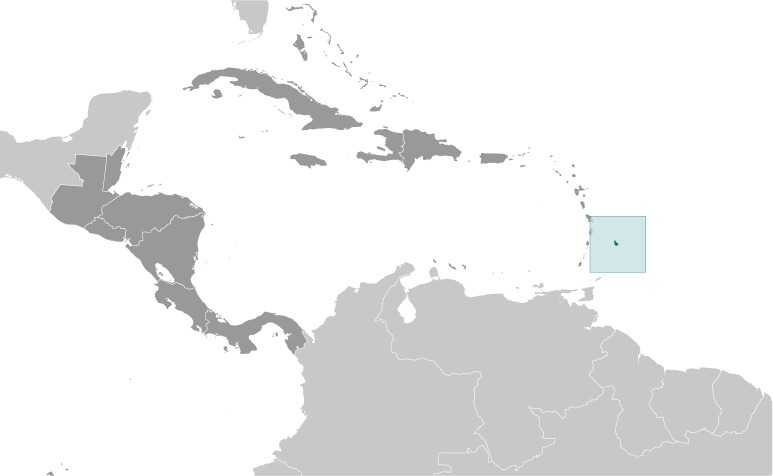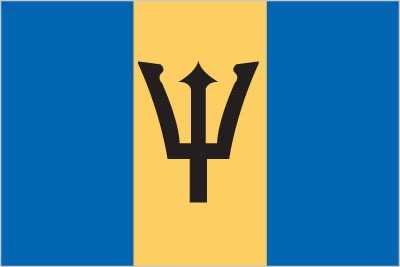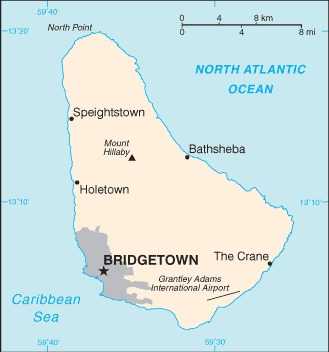Introduction
Background
Barbados was uninhabited when first settled by the British in 1627. By 1720, the island was no longer a dominant force within the sugar industry, having been surpassed by the Leeward Islands and Jamaica. Social and political reforms in the 1940s and 1950s led to independence from the UK in 1966. In 2021, Barbados became a republic.
Geography
Area
total : 430 sq km
land: 430 sq km
water: 0 sq km
Climate
tropical; rainy season (June to October)
Natural resources
petroleum, fish, natural gas
People and Society
Population
total: 304,139
Ethnic groups
African descent 92.4%, mixed 3.1%, White 2.7%, East Indian 1.3%, other 0.2%, unspecified 0.3% (2010 est.)
Languages
English (official), Bajan (English-based creole language, widely spoken in informal settings)
Religions
Protestant 66.4% (includes Anglican 23.9%, other Pentecostal 19.5%, Adventist 5.9%, Methodist 4.2%, Wesleyan 3.4%, Nazarene 3.2%, Church of God 2.4%, Baptist 1.8%, Moravian 1.2%, other Protestant 0.9%), Roman Catholic 3.8%, other Christian 5.4% (includes Jehovah's Witness 2.0%, other 3.4%), Rastafarian 1%, other 1.5%, none 20.6%, unspecified 1.2% (2010 est.)
Population growth rate
0.23% (2024 est.)
Government
Government type
parliamentary republic; a Commonwealth realm
Capital
name: Bridgetown
Executive branch
chief of state: President Sandra MASON (since 30 November 2021)
head of government: Prime Minister Mia MOTTLEY (since 25 May 2018)
Legislative branch
summary: bicameral Parliament consists of the Senate (21 seats) and the House of Assembly (30 seats)
Diplomatic representation in the US
chief of mission: Ambassador Noel Anderson LYNCH (since 11 January 2019)
Diplomatic representation from the US
chief of mission: Ambassador Roger F. NYHUS (since 19 January 2024) note - also accredited to Antigua and Barbuda, Dominica, Grenada, Saint Kitts and Nevis, Saint Lucia, and Saint Vincent and the Grenadines
Economy
Economic overview
largest Eastern Caribbean economy; dependent on US imports and currency strength; high Human Development Index; key tourism and financial sectors; declining but still very high public debt; cost-of-living and cost competitiveness vulnerabilities
Real GDP (purchasing power parity)
$4.92 billion (2023 est.)
$4.708 billion (2022 est.)
$4.148 billion (2021 est.)
Real GDP per capita
$17,400 (2023 est.)
$16,700 (2022 est.)
$14,800 (2021 est.)
Exports
$2.228 billion (2017 est.)
$2.41 billion (2016 est.)
$2.358 billion (2015 est.)
Exports - partners
US 23%, Jamaica 11%, Trinidad and Tobago 9%, Guyana 8%, Poland 6% (2022)
Exports - commodities
liquor, packaged medicine, ships, paper labels, baked goods (2022)
Imports
$2.12 billion (2021 est.)
$2.213 billion (2017 est.)
$2.238 billion (2016 est.)
Imports - partners
US 43%, China 8%, Trinidad and Tobago 7%, UK 5%, Netherlands 3% (2022)
Imports - commodities
refined petroleum, plastic products, cars, railway cargo containers, packaged medicine (2022)
Page last updated: Tuesday, September 03, 2024




